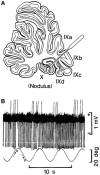Hypothesis: The Vestibular and Cerebellar Basis of the Mal de Debarquement Syndrome
- PMID: 29459843
- PMCID: PMC5807657
- DOI: 10.3389/fneur.2018.00028
Hypothesis: The Vestibular and Cerebellar Basis of the Mal de Debarquement Syndrome
Abstract
The Mal de Debarquement syndrome (MdDS) generally follows sea voyages, but it can occur after turbulent flights or spontaneously. The primary features are objective or perceived continuous rocking, swaying, and/or bobbing at 0.2 Hz after sea voyages or 0.3 Hz after flights. The oscillations can continue for months or years and are immensely disturbing. Associated symptoms appear to be secondary to the incessant sensation of movement. We previously suggested that the illness can be attributed to maladaptation of the velocity storage integrator in the vestibular system, but the actual neural mechanisms driving the MdDS are unknown. Here, based on experiments in subhuman primates, we propose a series of postulates through which the MdDS is generated: (1) The MdDS is produced in the velocity storage integrator by activation of vestibular-only (VO) neurons on either side of the brainstem that are oscillating back and forth at 0.2 or 0.3 Hz. (2) The groups of VO neurons are driven by signals that originate in Purkinje cells in the cerebellar nodulus. (3) Prolonged exposure to roll, either on the sea or in the air, conditions the roll-related neurons in the nodulus. (4) The prolonged exposure causes a shift of the pitch orientation vector from its original position aligned with gravity to a position tilted in roll. (5) Successful treatment involves exposure to a full-field optokinetic stimulus rotating around the spatial vertical countering the direction of the vestibular imbalance. This is done while rolling the head at the frequency of the perceived rocking, swaying, or bobbing. We also note experiments that could be used to verify these postulates, as well as considering potential flaws in the logic. Important unanswered questions: (1) Why does the MdDS predominantly affect women? (2) What aspect of roll causes the prolongation of the tilted orientation vector, and why is it so prolonged in some individuals? (3) What produces the increase in symptoms of some patients when returning home after treatment, and how can this be avoided? We also posit that the same mechanisms underlie the less troublesome and shorter duration Mal de Debarquement.
Keywords: baclofen; bobbing; gravity; nodulus; orientation vector; rocking; swaying; vestibular-only neurons.
Figures


Similar articles
-
Readaptation of the vestibulo-ocular reflex relieves the mal de debarquement syndrome.Front Neurol. 2014 Jul 15;5:124. doi: 10.3389/fneur.2014.00124. eCollection 2014. Front Neurol. 2014. PMID: 25076935 Free PMC article.
-
Treatment of Gravitational Pulling Sensation in Patients With Mal de Debarquement Syndrome (MdDS): A Model-Based Approach.Front Integr Neurosci. 2022 May 23;16:801817. doi: 10.3389/fnint.2022.801817. eCollection 2022. Front Integr Neurosci. 2022. PMID: 35676926 Free PMC article.
-
Lasting alteration of spatial orientation induced by passive motion in rabbits and its possible relevance to mal de débarquement syndrome.Front Neurol. 2023 Feb 22;14:1110298. doi: 10.3389/fneur.2023.1110298. eCollection 2023. Front Neurol. 2023. PMID: 36908625 Free PMC article.
-
Mal de débarquement syndrome.Handb Clin Neurol. 2016;137:391-5. doi: 10.1016/B978-0-444-63437-5.00028-5. Handb Clin Neurol. 2016. PMID: 27638086 Review.
-
Mal de Debarquement Syndrome.Semin Neurol. 2020 Feb;40(1):160-164. doi: 10.1055/s-0039-3402740. Epub 2020 Jan 27. Semin Neurol. 2020. PMID: 31986543 Review.
Cited by
-
Perceptual Postural Imbalance and Visual Vertigo.Curr Neurol Neurosci Rep. 2019 Mar 16;19(5):19. doi: 10.1007/s11910-019-0939-6. Curr Neurol Neurosci Rep. 2019. PMID: 30877392 Review.
-
Symptom reduction in mal de débarquement syndrome with attenuation of the velocity storage contribution in the central vestibular pathways.Front Rehabil Sci. 2024 Feb 29;5:1331135. doi: 10.3389/fresc.2024.1331135. eCollection 2024. Front Rehabil Sci. 2024. PMID: 38486679 Free PMC article.
-
Visual disorders and mal de debarquement syndrome: a potential comorbidity questionnaire-based study.Future Sci OA. 2022 Sep 14;8(7):FSO813. doi: 10.2144/fsoa-2022-0022. eCollection 2022 Aug. Future Sci OA. 2022. PMID: 36248065 Free PMC article.
-
Pilot study on patients with Mal de Debarquement syndrome during pregnancy.Future Sci OA. 2019 Feb 21;5(4):FSO377. doi: 10.4155/fsoa-2018-0109. eCollection 2019 Apr. Future Sci OA. 2019. PMID: 31114703 Free PMC article.
-
Approach to an experimental model of Mal de Debarquement Syndrome.J Neurol. 2019 Sep;266(Suppl 1):74-79. doi: 10.1007/s00415-019-09345-6. Epub 2019 May 2. J Neurol. 2019. PMID: 31049730
References
LinkOut - more resources
Full Text Sources
Other Literature Sources
Medical
Research Materials

